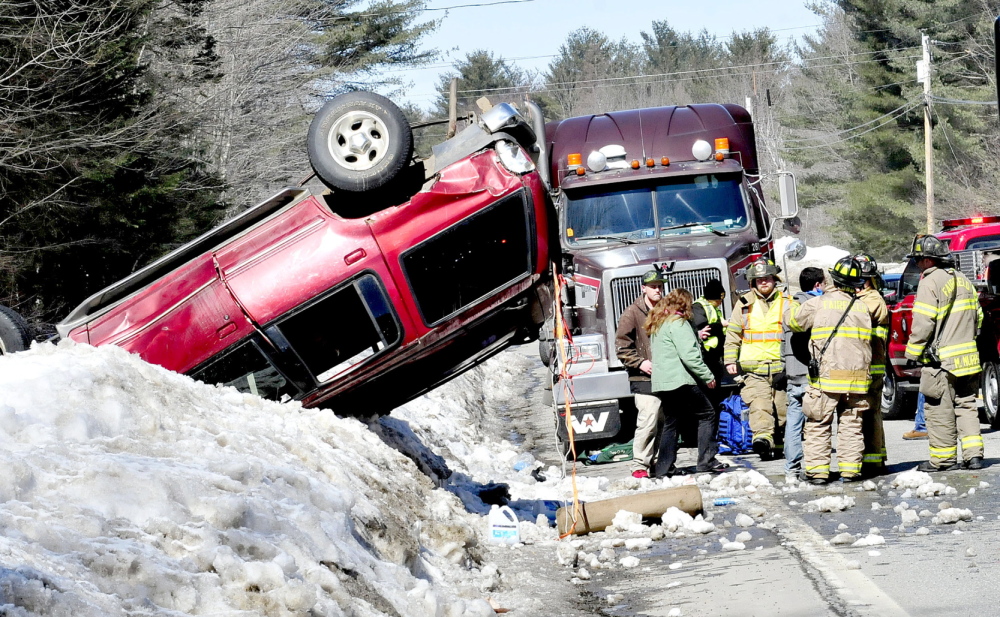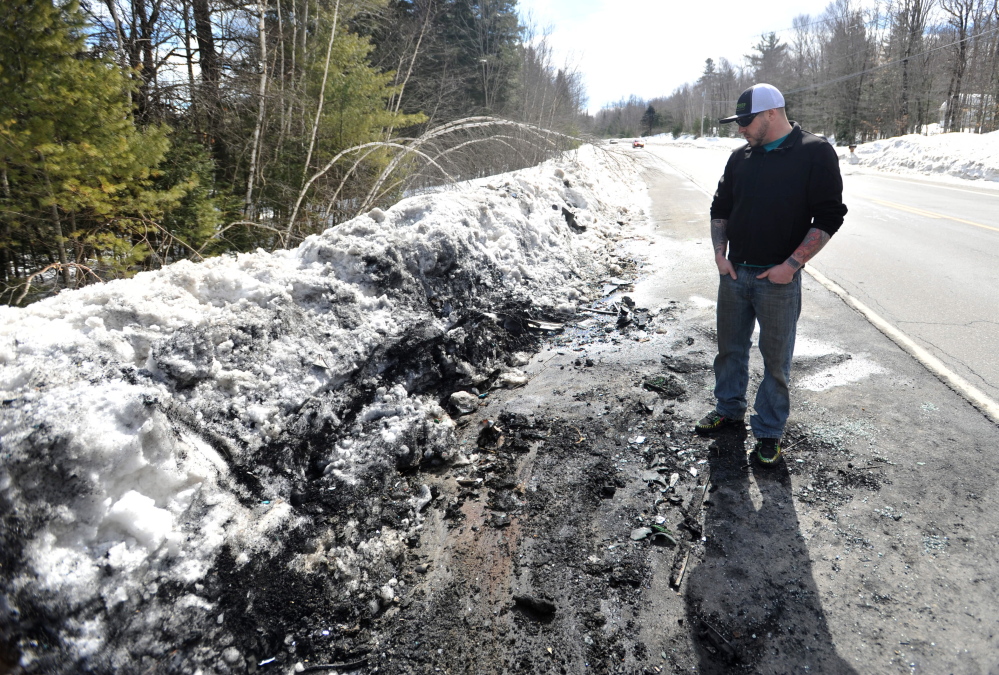FAIRFIELD — Several residents along Route 139 say the area where a woman died in a fiery crash Thursday night has posed a danger to drivers this winter and that the state should do more to prevent hazardous road conditions.
Officials from the Maine Department of Transportation said employees have been working hard to keep roads safe during an unusually cold and snowy winter.
Meanwhile, police said Monday they are still not able to identify the woman killed in the Thursday crash, saying results of DNA testing weren’t available yet. The woman’s body was taken to the Office of Chief Medical Examiner in Augusta for the testing because she couldn’t be identified because of the extent of the burns.
The crash, which incinerated the woman’s car, occurred just after 11 p.m. on Route 139, which is Norridgewock Road in Fairfield, about five miles south of the Norridgewock town line. Police said icy road conditions were a factor.
Thursday’s accident was the second fatal crash on the stetch in five months.
Along the same stretch of road Monday morning, an SUV rolled over several times, landing on its roof on a snowbank. One person was hospitalized after the crash, according to Fairfield police.
The night before Thanksgiving, Jim Murphy, a biochemist from Starks, was killed in a head-on crash on the road when an oncoming pickup truck crossed the center line.
Fairfield Police Chief Thomas Gould said the stretch of road from downtown Norridgewock to Fairfield Center where the accidents all happened is straight and wide open.
“I wish I had an explanation,” Gould said. “Both places where the two fatals that we recently had — you can see the location of both accidents right on that stretch of road — right in the same area. I really couldn’t say, other than ice and road conditions the other night.”
âA BAD SPOT’
But residents of the road say all the warning signs of an impending tragedy have been there this winter.
Dave Bickford, owner of Bickfordâs Greenhouse, has lived and worked a couple of miles from Thursday’s crash site since 1971. He said state plows didn’t push the snowbanks on the road back far enough to let melted water drain into the ditch.
“My thought is, if the snowbanks had been pushed back, the water wouldn’t have been running and wouldn’t have frozen,” Bickford said. “To me, it’s a slackness on the state’s part.”
He said that while much of Route 139 is straight and open, there is a problematic curve and slope a few hundred yards away that may have contributed to the deadly crashes.
“It’s a bad spot,” Bickford said. “It goes downhill and then bears to the right a little bit, and the sun doesn’t always hit it so well.”
John York, who operates Mickey’s Wrench auto repair garage, also pointed to the curve and slope.
York, who has driven plows for the departments of public safety in Fairfield and neighboring Oakland, also said he thinks the state’s plowing job has been lacking along Route 139.
On Monday, as York drove his plow from his business north toward the crash site, he said, “Try to look out for the traveling public’s safety, because that’s your job.”
At the curve in question, the road loses the convex bulge that ordinarily forces water directly to the shoulder. Instead, York said, the area is elevated, to better handle motorist traffic as it hits the curve.
In those conditions, he said, the snow has to be kept farther back from the road to prevent melted water from entering the pavement.
“When you have an elevated curve, you’ve got to push it way back,” he said.
As water crosses the pavement, car tires spread it hundreds of yards along the road, creating a large wet spot. At the curve itself, a bank of fir and pine trees shades the road, creating a temperature difference that will, in certain conditions, cause the melted water to freeze on a patch of the road.
State officials said plows regularly push the snow back between nine and 13 feet from the shoulder, but when York pulled back onto the road, he pointed out areas where the snowbank was much closer.
“Look, it’s almost into the travel lane right there,” he said.
York pulled off the road at a spot where blackened bits of debris and ash dirtied the snowbank — the site of Thursday’s fatal crash.
York said that the quality of the plow job, the terrain, the shade-throwing trees combined to create a dangerous patch of road.
âMOTHER NATURE WINS’
Ted Talbot, spokesman for the Department of Transportation, said the unusually fierce winter has wreaked havoc on the state’s roads, creating unusual challenges for maintenance teams.
“Resources are being used really to the extent that we haven’t had for many winters,” Talbot said. “With the fluctuating temperatures being what they are, it’s oftentimes a challenge.”
Talbot said the bad weather has created many more areas of concern than there would be in a typical winter, and that the department is responding as well as can be expected.
“The frost heaves and potholes are worse this year,” he said. “We’re losing not only our bad roads, but our good roads. In the end, Mother Nature wins.”
Talbot said there are many ways that a dangerous stretch of road might come to the state’s attention, and that none of them have happened so far for Route 139.
“If it’s a high crash area on our road, we would absolutely know that,” he said.
When a bad accident happens, he said, the transportation department receives a report from police investigators who will typically cite areas in which environmental factors may have played a role. In addition, if traffic data indicates that a particular turn or intersection is the site of a high number of crashes, it could trigger a review to identify possible causes.
Town officials can also request a traffic study.
York said that he has called the state about the dangerous conditions on Route 139, but that he had a difficult time getting a response.
Talbot said that neither he nor the region manager had any knowledge of complaints about the area. He also said that police reports have not yet shown what the causes of the fatal accidents have been.
Gould said authorities still are not commenting on the cause of the November crash that killed Murphy. He said police are still waiting for reconstruction reports so they can be turned over to the district attorney’s office.
Murphy, 67, was driving north when a southbound truck crossed the center line and hit his 1998 Subaru Outback head-on, police said at the time.
Thursday night, roads in the area were icy and Gould said the woman who died appears to have lost control of her car and slid into the path of an oncoming pickup truck, crashing into it head-on. Passersby tried to get the unconscious woman out of her car, but the heat from the fire made it impossible.
In Monday’s accident, Fairfield patrol Officer Shanna Blodgett said a car was stopped ready to make a turn about a mile south of Thursday’s fatality when a tractor-trailer slowed behind it.
A 2000 Ford Explorer driven by Erick Leary, 25, tried to pass the stopped car and truck, but the first car had already started to turn.
Leary overcompensated and rolled his SUV over several times, Blodgett said.
A passenger in the back seat, Angela Murry, 39, of Fairfield, was taken to the hospital injuries that didn’t appear to be life-threatening.
Blodgett said driver inattention and speed were contributing factors in Monday’s accident.
Doug Harlow — 612-2367 dharlow@centralmaine.com Twitter: @Doug_Harlow Matt Hongoltz-Hetling — 861-9287 mhhetling@centralmaine.com Twitter: @hh_matt
Send questions/comments to the editors.




Success. Please wait for the page to reload. If the page does not reload within 5 seconds, please refresh the page.
Enter your email and password to access comments.
Hi, to comment on stories you must . This profile is in addition to your subscription and website login.
Already have a commenting profile? .
Invalid username/password.
Please check your email to confirm and complete your registration.
Only subscribers are eligible to post comments. Please subscribe or login first for digital access. Here’s why.
Use the form below to reset your password. When you've submitted your account email, we will send an email with a reset code.